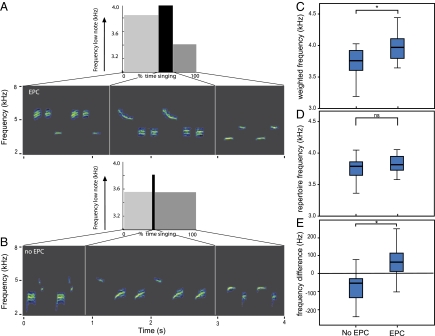Fig. 2.
Males singing low-frequency songs suffer less paternity loss. (A and B) Examples of song type repertoires and song type use for two neighboring males in relation to paternity loss. (A) The cuckolded male (EPC) has similar song types compared with (B) the noncuckolded male (no EPC), and the neighbors mainly differ in the percentage of time during which they use their low- and high-frequency song types. Sonograms show their repertoires consisting of three song types, and the graphs show the peak frequency of the lowest note in relation to the percentage of time that the individual is using a particular song type. (C and D) Box-whisker plots showing differences in song behavior between paternity groups. (C) Non-cuckolded males sing, on average, lower than cuckolded males during the dawn chorus at the peak of female fertility (LMM; F1,21 = 6.84, *P = 0.018). (D) Differences cannot be ascribed to noncuckolded males having lower song types in their repertoire (LMM; F1,21 = 1.64, P = 0.22; peak frequencies of low notes averaged over song types of an individual's repertoire). (E) Differences are the result of using the lower song types more often [LMM; F1,21 = 7.39, *P = 0.014; difference between average weighted song frequency (C) and frequency averaged over repertoire (D) per individual.]

